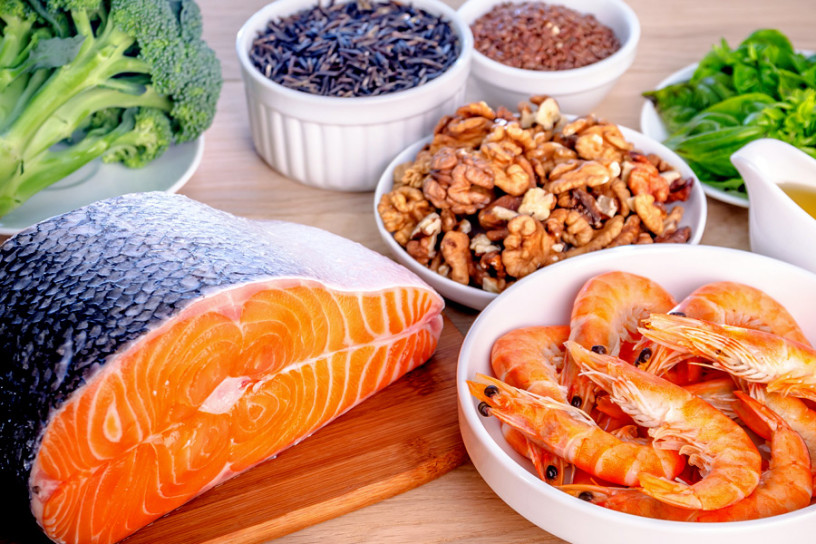We’ve all heard that Omega-3 fatty acids are beneficial to our health.
At least once a week, I hear something on the news or read something in a magazine that tells me I need more Omega-3 fatty acids in my diet. But what is an Omega-3 fatty acid? Is there a difference between Omega-3 and Omega-6? How will it help my health and where do I find them?
Those are the questions that I will discuss in this post.
Omega-3 fatty acids are polyunsaturated fatty acids that are essential nutrients for health. They are considered essential since our bodies can not make them on their own; we have to ingest them to survive.
There are three types of Omega-3 fatty acids, they include EPA, DHA and ALA. The first two, EPA and DHA, are found primarily in oily fish and the third, ALA, is found in plant sources such as walnuts and flax. Omega-3 fatty acids are required for numerous body functions including building cell membranes within the brain and controlling blood clotting. New studies on omega-3 fatty acids show a wide variety of benefits including protection against heart disease, rheumatoid arthritis and cancer. Omega-3 fatty acids also help protect your skin from damage caused by the environment and our diet.
Omega-3 also has been found to have strong anti-inflammatory properties- this may in turn help to reduce the risk and symptoms of illnesses that are influenced by inflammation.
Now that we have covered Omega-3 fatty acids, let’s discuss the difference between Omega-3 and Omega-6 fatty acids, and why there is such a buzz surrounding only the Omega-3. Omega-6 fatty acids are also an essential fatty acid, our body needs them for brain function and normal growth. The primary difference from a wellness standpoint is that Omega-6 fatty acids promote inflammation. The key to good health is having a balance between Omega-3 and Omega-6, and that is where the challenge lies.
Here in the United States most of the oils that we cook with and that are used in processed foods are safflower, corn and soybean. All of these oils are very high in Omega-6 and have little or no Omega-3. So in order to achieve a balance you must either supplement with Omega-3 fatty acids, or stop eating processed and fried foods and focus on a more natural and well balanced diet.
Now that you know what an Omega-3 fatty acid is, and the benefits to increasing your intake, where can you find them?
The best way to get Omega-3 fatty acids is through food, that way the oil is unprocessed, and you will also benefit from all of the other micro-nutrients found in whole foods.
Flaxseed
Flaxseed is the richest source of ALA. Grind up 2 tablespoons of flax and sprinkle it on your yogurt, cereal or add it to your protein shake. Not only will you get a large dose of Omega-3 fatty acids but you will also add fiber to your diet.
Cold Water Fish
Salmon is the most talked about fish that is high in Omega-3 fatty acids, but any sustainable cold water fish will increase your Omega-3 intake. If you don’t care for salmon, try trout, mackerel, herring or halibut.
Walnuts
Walnuts contain more ALA than any other nut. They can easily be sprinkled on salads, cereal, oatmeal and even added to baked goods.
Enriched Eggs
Omega-3 enriched eggs contain all three types of Omega-3 fatty acids. Farmers add flaxseed and algae to the diets of egg-producing hens. These specially designed eggs contain about 150 milligrams of Omega-3 per egg. The amount of Omega-3 found in these eggs is relatively low compared to other foods, but it is still three times more than is found in a regular egg. This can be a huge benefit if you do not care for fish. When looking for Omega-3 enriched eggs choose a cage free variety, there will be even more nutrients and benefits in those.
Sardines
Sardines are my go-to food when traveling or in a hurry. These tiny fish contain a large amount of Omega-3, are high in protein, are inexpensive, and convenient. Canned sardines have a similar taste to tuna fish, and can be used the same way as you would tuna. An added benefit is that sardines do not have the high amounts of mercury that tuna can contain.
Olive Oil
Olive oil contains more Omega-3 fatty acids than any other cooking oil. Try using light olive oil in place of vegetable oil when cooking. Light olive oil still has the benefits of higher Omega-3 fatty acids but without the strong fruity taste of extra virgin olive oil.
Supplements
If you do not have a taste for any of these foods or just want your Omega-3 intake to be more convenient, try one of the many supplements that contain Omega-3 fatty acids. Choose either a fish oil supplement or high lignan flax oil. These supplements will boost your Omega-3 fatty acid intake quickly and easily. These supplements come either in oil form or in capsules. Buying the oil is a much more cost effective way to supplement, and while in the past taste was a major deterrent, new formulas have both the fish and flax oil tasting great.
Omega-3 fatty acids have tremendous health benefits and are easily added into everyone’s diet… So what are you waiting for?
Go grab those flax crackers, open a can of sardines, and say hello to a healthier life!

